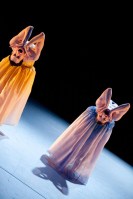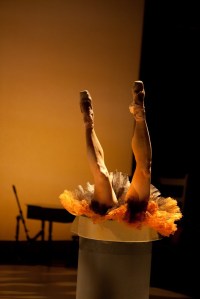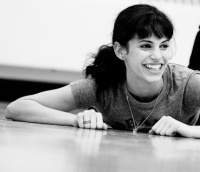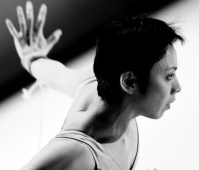Some thoughts after reading a series posts about Whim W’Him’s first program—by Donald Byrd on his Spectrum blog, Jen Graves on The Stranger‘s blog, SLOG, and Jeremy M. Barker on The SunBreak, as well as various other comments and responses.
Three loaded issues intersect here:
Artists do not create ex nihilo. Life counts.
The role of Kaori Nakamura, Olivier Wevers’s former wife, is central to 3Seasons. The woman in the battered tutu appears to stand for nature or the environment; or for what is good and true in humanity; or even, arguably, for women. So what, several people have asked, does it say about a choreographer when he casts his ex-wife in a role in which she is “humped” (Byrd’s term) by his current (male) spouse and then, at the end of the piece—adding injury to insult—thrown in a garbage can after being smeared with blood?*
*[Couple of corrections. First, the “blood” smeared was intended to be earth. At dress rehearsal the night before opening, the available dirt material, “Texas red,” was used the first time. On stage it looked red like blood, but Olivier found that interesting (blood of the earth?). Second: as noted and corrected by Barker online, the “rapist” was Jonathan Poretta, not Lucien Postlewaite, Olivier’s husband.]
Does it make a difference, to objections like these, that as a dancer Kaori was the clear choice in this role?—for her formidable technique and great dramatic power; her small stature; her brave, adventurous and willing spirit; her eagerness to try out new, difficult roles; her continued closeness to Olivier Wevers and understanding of what he was trying to convey.
Or that likewise he has worked extensively with PNB’s Jonathan Poretta and Lucien Postlewaite and knew what they could do and what choreographic demands he could make on them, as he had done for their danced dialogue in X Stasis?
And what should one make of the fact that in all the conversations I had (for the Whim W’Him blog e-whims) with collaborators on this project, everyone—to a wo/man—commented on the rare level of camaraderie and mutual respect, the interest and willingness to learn from each other, that characterize this new dance venture? Observing many rehearsals, downtime interactions, and all three performances, I can only conclude they meant what they said.
The role of biography in art is not irrelevant. It’s just very complicated…
2) Women in Whim W’Him director Olivier Wevers’s choreography.
What does Olivier’s use of pointe shoes signify? Since they surely do carry the freight of a couple of centuries of ethereal sprites, are they therefore incapable for all time of expressing anything else? Can they not ever be used in other, more earthbound ways?
 Or would they have to be adopted equally by men and women in non-drag dance for them to be considered legitimate vehicles for artistic expression? Yet it would surely be naïve to assert that men and women properly must have interchangeable roles in dance (which is why, by the way, I think Olivier’s response that it didn’t make any difference whether FRAGMENTS was performed by 2 women or a man and a woman was rather facile, and in fact quite inaccurate. One casting choice isn’t necessarily better or worse, but it surely does make a difference). The sex we are born with, however we choose to express it or amend it as adults, is one of our most basic characteristics. (The first question asked of new baby is “What is it?” and that means “What sex”?) It does make a difference, in life and in dance.
Or would they have to be adopted equally by men and women in non-drag dance for them to be considered legitimate vehicles for artistic expression? Yet it would surely be naïve to assert that men and women properly must have interchangeable roles in dance (which is why, by the way, I think Olivier’s response that it didn’t make any difference whether FRAGMENTS was performed by 2 women or a man and a woman was rather facile, and in fact quite inaccurate. One casting choice isn’t necessarily better or worse, but it surely does make a difference). The sex we are born with, however we choose to express it or amend it as adults, is one of our most basic characteristics. (The first question asked of new baby is “What is it?” and that means “What sex”?) It does make a difference, in life and in dance.
And how does Olivier approach women?
Does he put them in oversimplified pigeonholes, or fail to give them their due as complex beings or subject them to uniformly bad treatment in 3Seasons? in the OtB program? in his work as whole?
Can stereotypes ever be used to make a cogent point? Should women never be treated badly in dance even if they are in life? Should men? Does the ill treatment of a person or the scrutiny of a stereotype in a work of dance disqualify it as serious or legitimate art? Does art have a moral duty?
What are we to make of the 3 Seasons sequence known as “the kiss”? or the other couple’s convoluted twistings on the floor at the same time? or the flirtatious romps of 3 men with 3 women? or Kaori’s solos? Or, for that matter, how should we construe the 2 male-female or male-male duets in X Stasis? The convoluted FRAGMENTS duo?

 As 3Seasons costume designer Michael Cepress remarks, there’s a whole MA thesis on gender in the Whim WHim program at OtB…
As 3Seasons costume designer Michael Cepress remarks, there’s a whole MA thesis on gender in the Whim WHim program at OtB…
3) Aesthetic judgment about 3Seasons
Many of the above questions will be answered differently depending on one’s tastes and artistic/sexual/political orientation. But in the end, as several people have pointed out, we are dealing with a work of art. In the interest of judging it as such, it might be worthwhile looking again at the card handed out to audience members at the On the Boards A.W.A.R.D show last December. It contained some question to consider while watching the dance performances—before we get lost in the many possible social and ethical issues, we might reread them and take them into account in judging 3Seasons in and for itself as dance art:
•What was your first impression?
•Did the work have a clear vision/direction?
•Was the choreography engaging?
•Did the music/soundtrack support the dance?
•Did the choreographer use the space effectively?
•Was the movement original? (how do you define original?)
•Was the performance of the movement articulate?[•along with a somewhat different question—Was it well executed?]
•Did the piece evoke or provoke any emotions in you?
•Was the work thought-provoking?
•When the performance ended, were you left wanting more?





